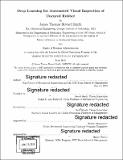| dc.contributor.advisor | David Hardt and Roy Welsch. | en_US |
| dc.contributor.author | Smith, James Thomas Howard | en_US |
| dc.contributor.other | Leaders for Global Operations Program. | en_US |
| dc.date.accessioned | 2018-10-22T18:45:14Z | |
| dc.date.available | 2018-10-22T18:45:14Z | |
| dc.date.copyright | 2018 | en_US |
| dc.date.issued | 2018 | en_US |
| dc.identifier.uri | http://hdl.handle.net/1721.1/118694 | |
| dc.description | Thesis: S.M., Massachusetts Institute of Technology, Department of Mechanical Engineering, in conjunction with the Leaders for Global Operations Program at MIT, 2018. | en_US |
| dc.description | Thesis: M.B.A., Massachusetts Institute of Technology, Sloan School of Management, in conjunction with the Leaders for Global Operations Program at MIT, 2018. | en_US |
| dc.description | Cataloged from PDF version of thesis. | en_US |
| dc.description | Includes bibliographical references (pages 85-89). | en_US |
| dc.description.abstract | This thesis proposes a data-driven approach to automate the visual inspection of uncured rubber tire assemblies. Images collected from a machine vision system are used to develop proof of concept predictive models to automate the visual inspection step for tread caps. The developed binary model exhibits an AUC of 0.91 on the test set and a simulated business scenario shows this performance can reduce manual inspection time by 16-70%, depending on the selected decision threshold determined by business needs. This appears to be the first study to develop a method that successfully detects and locates a wide range of uncured rubber nonconformities. The multiclass model also exhibits promising ability to distinguish between different nonconformity types. The results of this study can be used to inform the investment decisions required to fully automate the process. It will be straightforward to adapt the models to predict nonconformities on the rest of the uncured assembly surface when that data becomes available. Of interest to the machine learning community, the empirical work required to develop these models highlights several key insights. A comparison is made of techniques used to address class imbalance in neural network training. For our problem, a penalized loss function is superior for binary classification, while oversampling performs best for the multiclass problem. The study also highlights the importance of analyzing to what extent a pre trained network should be transferred. For our problem, removing the final convolutional layers of the pretrained network significantly improves performance. While the specifies of these findings are likely unique to our problem, this study highlights the importance of these decisions when training neural networks on relatively small and imbalanced training sets. | en_US |
| dc.description.statementofresponsibility | by James Thomas Howard Smith. | en_US |
| dc.format.extent | 89 pages | en_US |
| dc.language.iso | eng | en_US |
| dc.publisher | Massachusetts Institute of Technology | en_US |
| dc.rights | MIT theses are protected by copyright. They may be viewed, downloaded, or printed from this source but further reproduction or distribution in any format is prohibited without written permission. | en_US |
| dc.rights.uri | http://dspace.mit.edu/handle/1721.1/7582 | en_US |
| dc.subject | Mechanical Engineering. | en_US |
| dc.subject | Sloan School of Management. | en_US |
| dc.subject | Leaders for Global Operations Program. | en_US |
| dc.title | Deep learning for automated visual inspection of uncured rubber | en_US |
| dc.type | Thesis | en_US |
| dc.description.degree | S.M. | en_US |
| dc.description.degree | M.B.A. | en_US |
| dc.contributor.department | Leaders for Global Operations Program at MIT | en_US |
| dc.contributor.department | Massachusetts Institute of Technology. Department of Mechanical Engineering | |
| dc.contributor.department | Sloan School of Management | |
| dc.identifier.oclc | 1056954044 | en_US |
